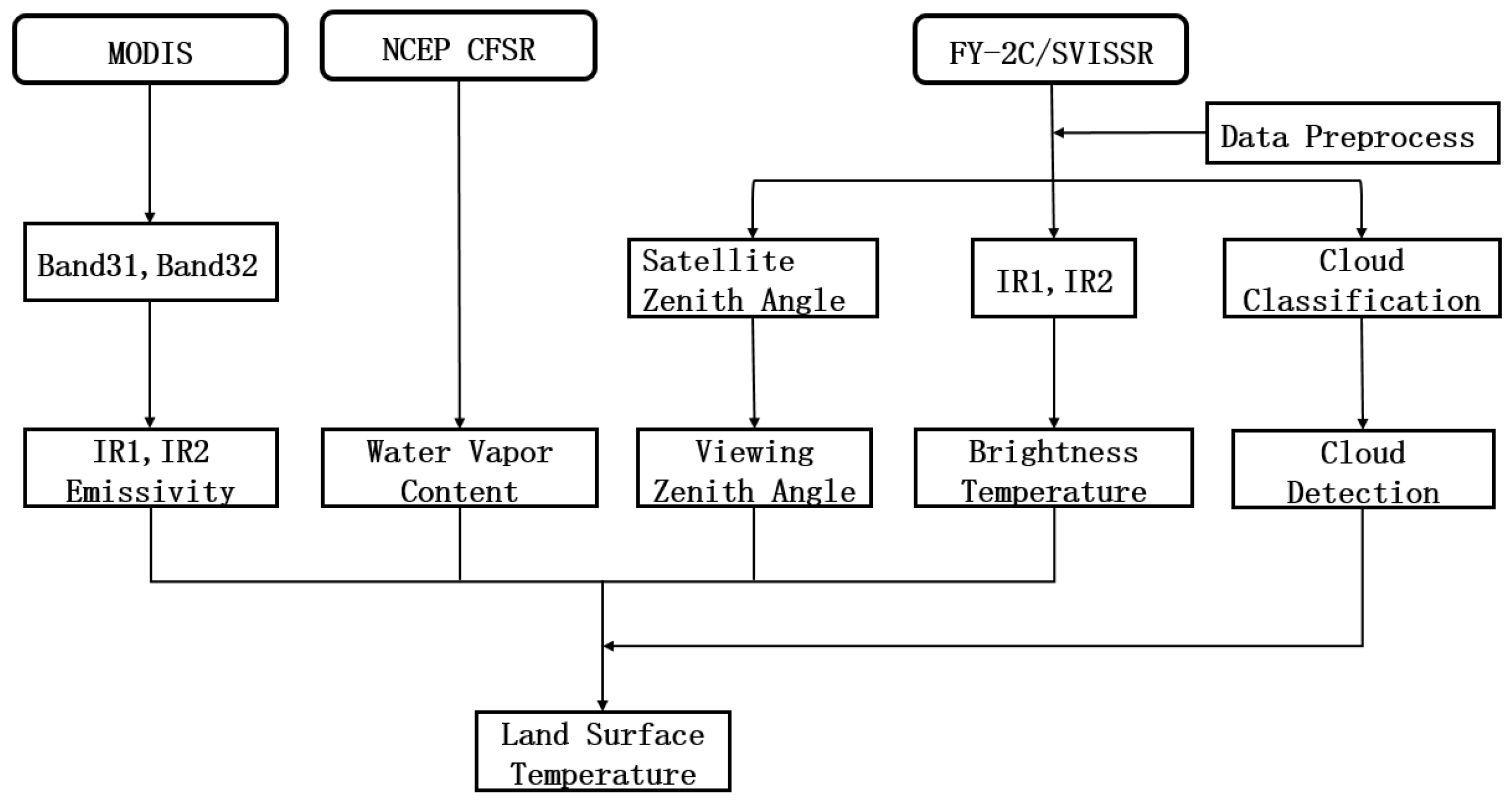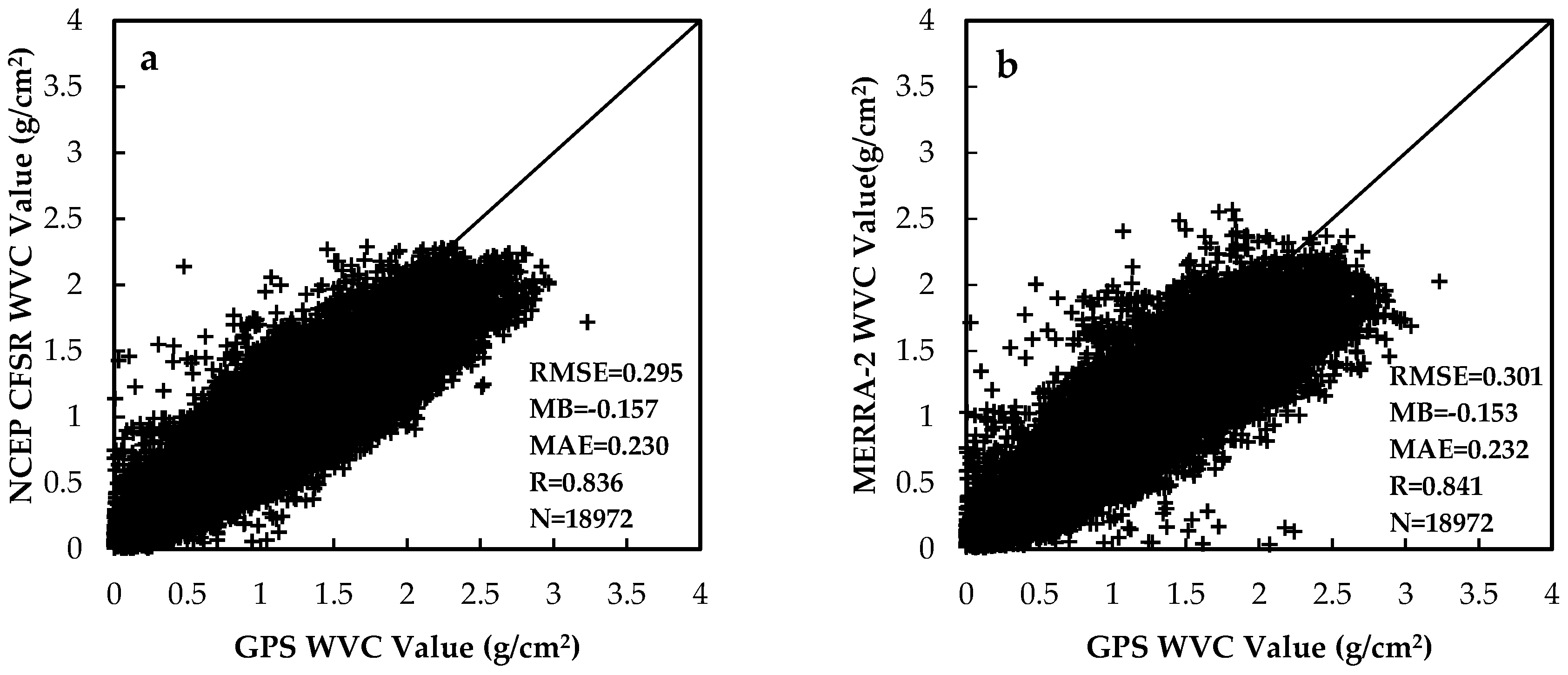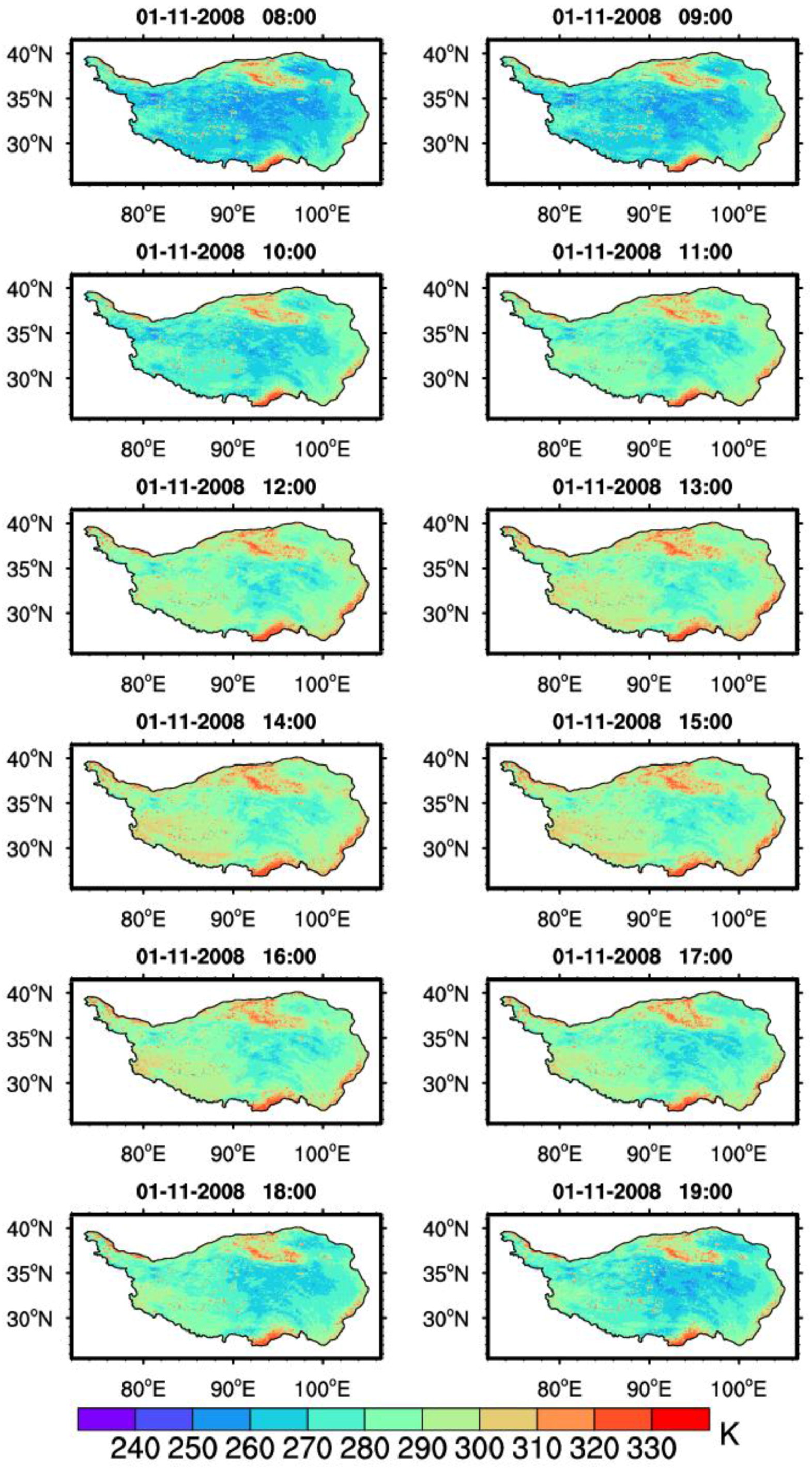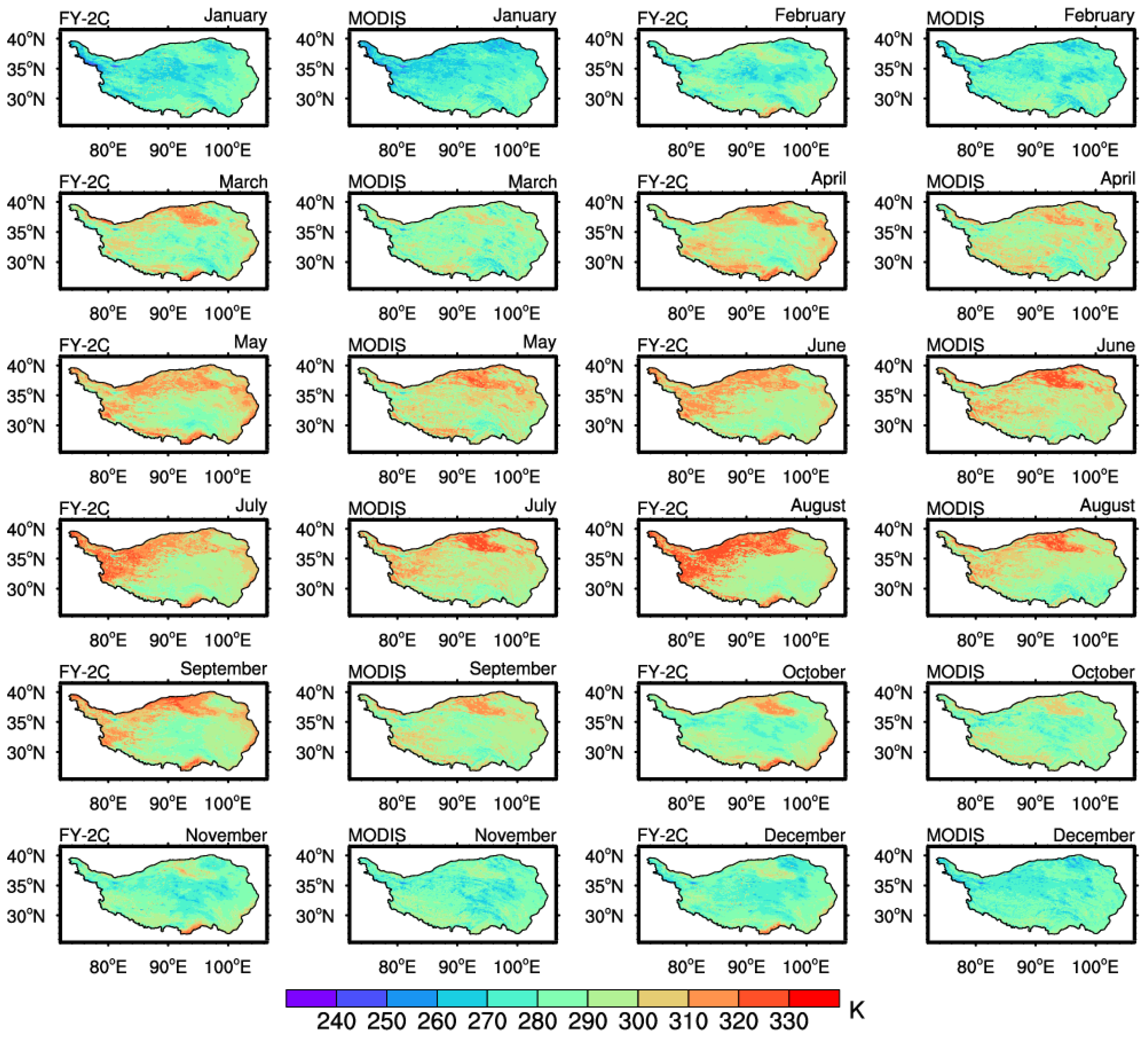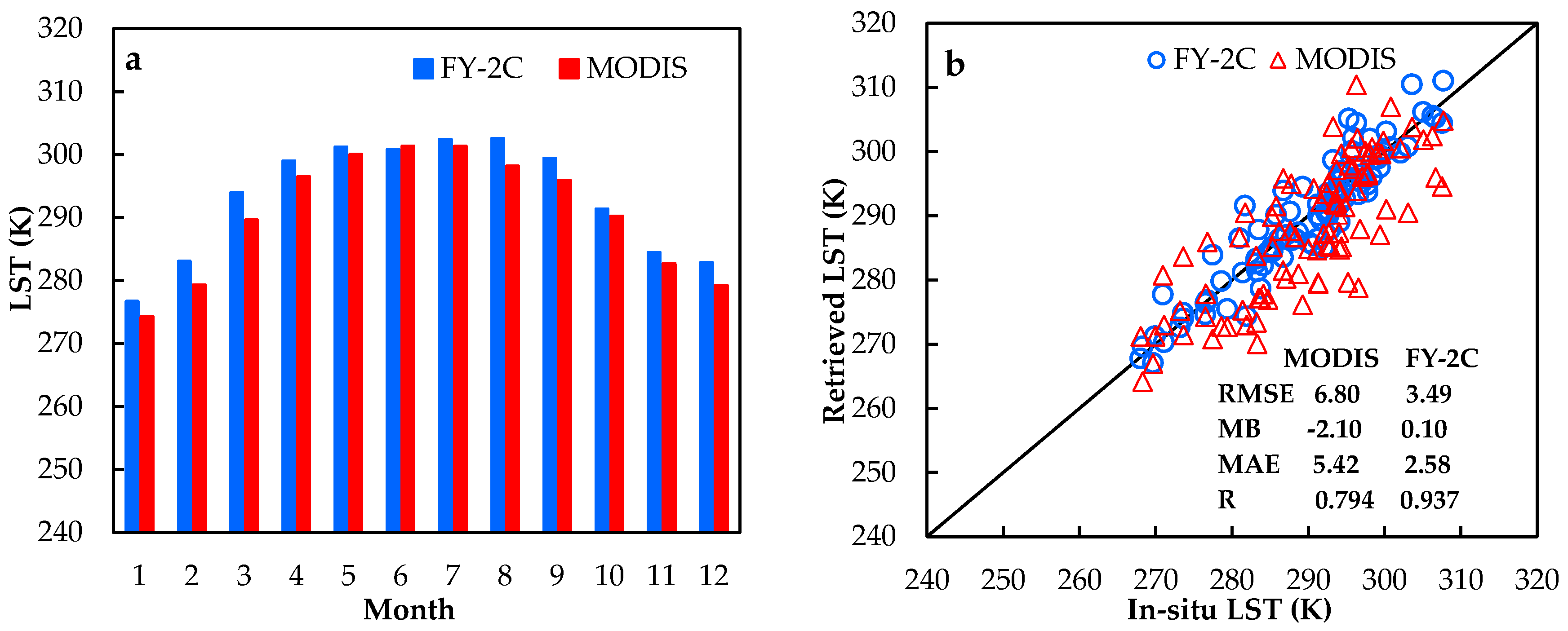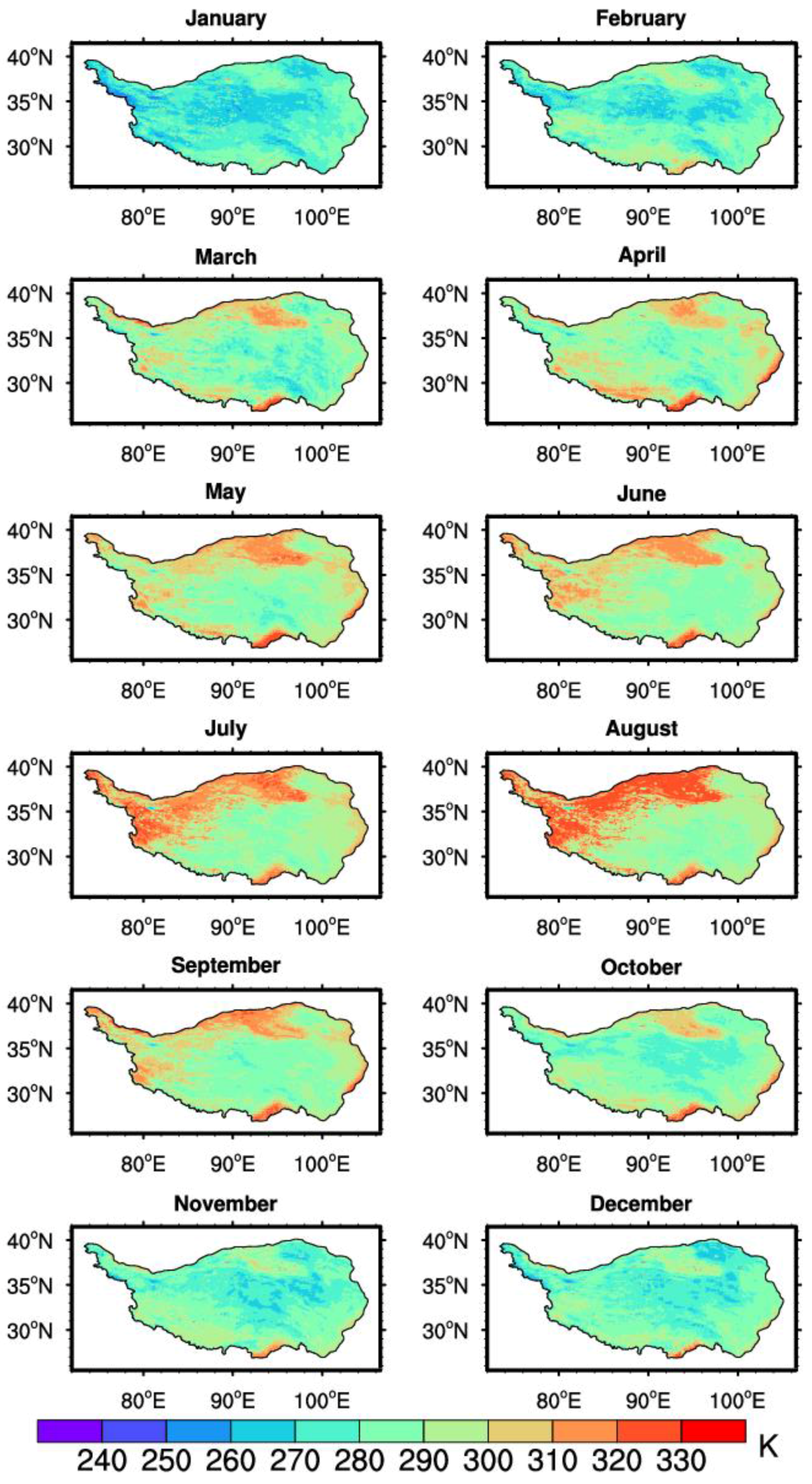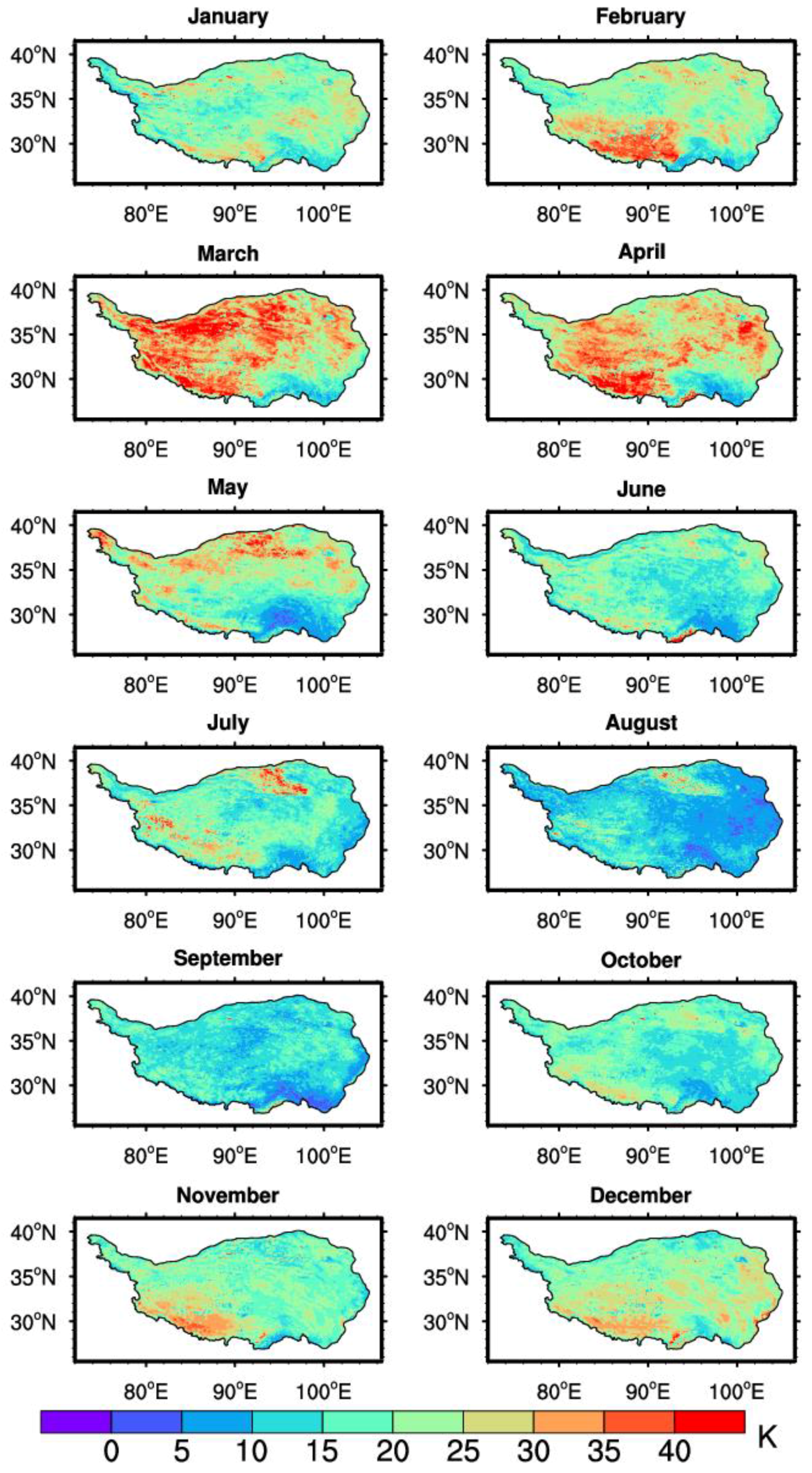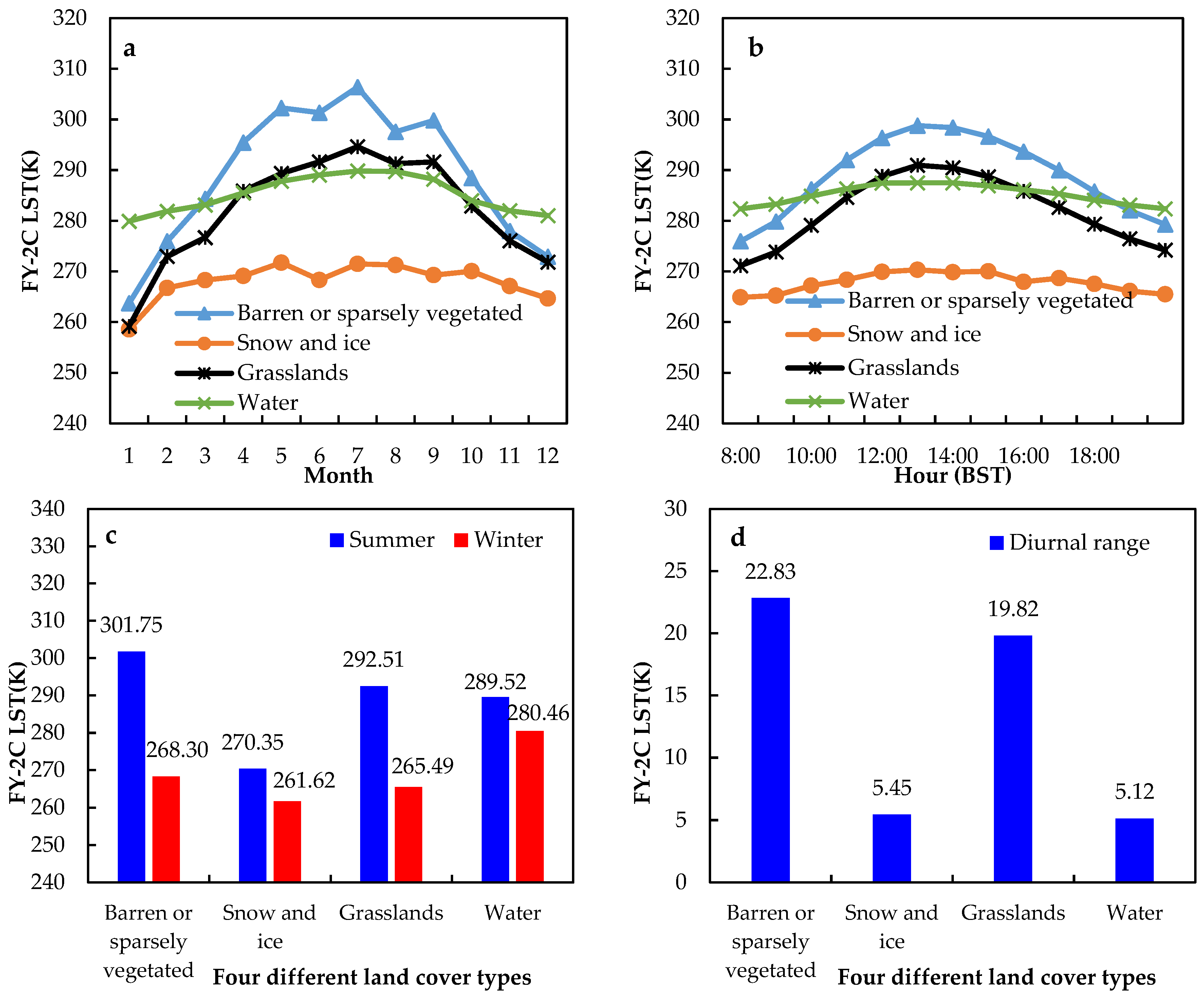1. Introduction
During the process of land–atmosphere interaction, the land surface temperature (LST) is a pivotal parameter for characterizing energy as well as the mass exchange between the atmosphere and the ground surface [
1]. It is also crucial to the study of the surface energy balance [
2,
3,
4,
5] and is extensively needed in a variety of fields, especially in meteorology, geology, hydrology, and ecology, among others [
6,
7,
8,
9,
10]. Reputed as the world’s highest plateau and the “Roof of the World”, an average elevation of the Tibetan Plateau (TP) is approximately 4000 m. Because of its thermodynamic and dynamic effects, the TP is vitally important to the atmospheric circulation and climate change in Asia and even the Northern Hemisphere [
11]. According to prior research, the thermal effects of the TP greatly influence the monsoon outbreak and atmospheric circulation [
12,
13,
14,
15,
16]. Under the global warm climate, it is vital to investigate the heating source changes in the TP; meanwhile, the LST is one of the heating-source indicators [
17]. As such, it is essential to accurately gain the spatio-temporal distribution of the LST in the TP area.
However, the traditional way of LST ground measurement is conducted at the point scale. It is insufficient to meet the current regional-scale application requirements [
18,
19]. Fortunately, satellite remote sensing technology can partially make up for these deficiencies. The thermal infrared data and the remote sensing approaches are utilized to describe LST on a regional or even global scale [
20,
21,
22,
23]. According to the thermal bands involved, the LST retrieval methods could be cursorily divided into three categories: single channel method, multiangle method and multichannel method [
23]. Recent research has developed new physically based schemes, which retrieve simultaneously LST and land surface emissivity (LSE) with high accuracy [
24,
25,
26,
27,
28,
29]. Based on static physical schemes and observational data from multiple time steps, Li et al. [
24] and Li et al. [
25] derive the LST and LSE simultaneously. Masiello et al. [
26], Masiello and Serio [
27], and Masiello et al. [
28] utilized the Kalman filter (KF) method, which is a dynamical physical-based scheme and novel approach to directly retrieve LST and three channels’ LSEs. The accuracy of the retrieval result is about ±0.2 °C and ±0.005, respectively. Rozenstein et al. [
29] used the KF approach to study the diurnal LSE dynamics in a coastal desert area, which further demonstrated the reliability of the KF method. However, the traditional KF algorithm is only applicable to the linear Gaussian system. In addition, these simultaneous methods are more complex and only applicable to experimental setups, which may limit the wide use of these simultaneous approaches [
30]. Operationally, as one of the most widely used and the most fully developed multichannel algorithms, the split window algorithm (SWA) available to derive the LST precisely without atmospheric vertical profile information. At present, more than twenty SWAs have been published. Based on two different polar-orbiting satellites data (Advanced Very High Resolution Radiometer (AVHRR) and the Moderate Resolution Imaging Spectroradiometer (MODIS)), Sobrino et al. [
31,
32] utilized a novel SWA to retrieve the LST with high precision. On the basis of simplifying the radiation transfer equation, Qin et al. [
33] proposed a SWA that involves only emissivity and transmittance parameters and the accuracy of retrieval LST is below 2 K. Besides the AVHRR [
18,
19,
31,
33,
34] and MODIS [
32,
35,
36], the SWA has been succeeding in the application for estimating the LST from instruments onboard other polar-orbiting satellites, including the Landsat-8 Thermal Infrared Sensor (TIRS) [
37,
38], the Advanced Spaceborne Thermal Emission and Reflection Radiometer (ASTER) [
39], etc. Since the LST has a high temporal variability that is especially large in a diurnal cycle [
10], it is often inadequate to use the LST retrieved by polar-orbiting satellites, which has low temporal resolution, for many applications such as numerical weather forecasting and ecosystem process modeling.
Meanwhile, many geostationary meteorological satellites have been launched in space successfully and hourly remote sensing data have gained increasing attention. The geostationary meteorological satellite has a high time resolution [
40], and the diurnal variation of various parameters of the surface can be captured. Therefore, the hourly LST data can be obtained using the geostationary meteorological satellite data. Tang et al. [
41] estimated the LST for cloud-free skies around Beijing in China from data from FengYun-2C (FY-2C), which are the first operated geostationary meteorological satellites of China. However, the results have not yet been evaluated due to lacking of in-situ observations. Ouyang and Li [
42] modified a general SWA and a cross-calibration method for the FY-2C/the Stretched Visible and Infrared Spin Scan Radiometer (SVISSR) satellite data and calculated the LST in the area of Heihe River Basin. The retrieval LST was validated after the aggregated Advanced Along-Track Scanning Radiometer (AATSR) derived the LST with in situ observations. The SVISSR and aggregated AATSR gave comparable results (within 4 K). However, there was an overestimation of approximately 3 K for the AATSR LST product compared to the ground measurements, and the LST was retrieved only for two days (7 and 10 December 2007). Jiang and Liu [
43] improved the SWA using the moderate spectral resolution atmospheric algorithms and computer model (MODTRAN) and retrieved the LST from the FY-2C/D/E (located above the equator at longitude 105° E, 86.5° E and 123.5° E, respectively) measurements. The retrieval of the LST was cross-validated with the MODIS products (the total errors of the FY-2C/D/E are
K,
K, and
K, respectively). However, the data from only two time spans (September 2007 for FY-2C/D/SVISSR and May 2010 for FY-2E/SVISSR) were chosen to calculate the LST. Oku and Ishikawa [
44] calculated the hourly LST from the Geostationary Meteorological Satellite Visible/Infrared Spin-Scan Radiometer (GMS VISSR) data over the TP in 1998. The correlation coefficient is approximately 0.8 between the calculated LST and in situ observations, and there is a large root mean square error (RMSE) of nearly 10 K.
There are actually some published SWAs to calculate the LST. However, if the coefficients in SWAs are not optimized, the existing SWAs are not suitable for estimating the LST over a certain region, especially for the most challenging area of the TP. For the time being, there is also a lack of LST products with high accuracy and temporal resolution. Thus, this paper aims to establish a SWA suitable for the retrieval time series of LST with resolution and high accuracy over the TP. The spatio-temporal LST variation patterns and its relationship with environmental factors will also be identified. The structure of the article is as below. The introduction of the data and study area is shown in
Section 2. In
Section 3, the methodology adopted in this study is introduced. The validation results of LST derived from modified SWA, the spatio-temporal LST variation characteristics and its relationship with the underlying surface types are presented in
Section 4. The last part provides the conclusions, including concluding remarks and discussion.
4. Results and Discussion
A total number of eight stations with LST measurements were available in this study, seven of which were used to build the SWA while one independent station was used to do the cross validation.
Figure 4 demonstrates the validation between the retrieved LST from BL95 (a) (using the BL95 regression coefficients [
59]), the improved SWA; and (b) against the field measurements (one-year data). As shown in
Figure 4, the improved SWA has lower RMSE (2.26 K), MB (0.83 K), MAE (1.91 K), and higher R (0.987) than BL95 (with RMSE, MB, MAE and R values of 6.99 K, −5.33 K, 5.97 K and 0.941, respectively), which means that the improved SWA could provide a better estimation of LST than the BL95. According to the statistical results above, it is obvious that there is no universal SWA. Especially for the area of the TP, it is necessary to modify a SWA to achieve LST with high accuracy according to local surface and atmospheric conditions.
Using the improved SWA, the LST in 2008 was calculated over the TP. To reduce the cloud impact, the MVC method [
60] was applied for each pixel in the image. The composite data are produced for every 10-day interval from the derived LST.
Figure 5 demonstrates the spatio-temporal distribution of the 10-day composite hourly LST from 8:00 a.m. to 7:00 p.m. BST on 1 November 2008. It is easy to see that the diurnal variation of the LST is distinct over the TP area. From 8:00 a.m. to 7:00 p.m. (BST), the LST increases by more than 30 K in the western parts of the TP, while there is only a slight increase in the LST in the eastern and central area of the Plateau.
To further validate the improved SWA for the FY-2C, the MODIS LST products were chosen for comparison. As is well known, the transit time of the Terra satellite is at approximately 10:30 a.m. (local time). Therefore, for contrasting to the MODIS LST product, the average value of the retrieved LST at two time points closest to the transit time was calculated. The detailed spatio-temporal distribution is shown in
Figure 6. It can be observed that the LST of these two datasets has a similar spatial distribution. The monthly mean values of the LST show clear seasonal variation. The southern and western parts of the TP and the Qaidam Basin region can be clearly identified as high value centers, and the area of the Kunlun Mountains has relatively low LST due to its high altitude.
Figure 7a shows the histograms of the monthly average LST values over the TP from the FY-2C retrieval and MODIS product. The MODIS LST product is usually lower than the derived LST. Subsequently, the in situ observations were utilized to evaluate the retrieved LST and MODIS product. The RMSE, MB, MAE and R of the MODIS product are 6.80 K, −2.10 K, 5.42 K, and 0.794, respectively, while those of the derived FY-2C LST are 3.49 K, 0.10 K, 2.58 K and 0.937. The derived FY-2C LST using this modified SWA is more accurate than the MODIS product over the TP area.
The monthly mean of the daily maximum and minimum LSTs were further derived to study the LST variations in different regions of the TP.
Figure 8 demonstrates the spatio-temporal distribution of the monthly mean of the daily maximum LST in 2008. The daily maximum LST in the central part was lower than that in other parts of the TP. From April to October, there were clearly greater LST centers of daily maximum LST in the southern and western parts of the TP and the Qaidam Basin area. This may be due to the difference of the underlying surface conditions. The western part of the TP and Qaidam Basin area (where a desert is located) are relatively dry, and radiative cooling during night is expected to be much stronger there than that in the east. Besides the surface of Qaidam Basin area and the western plateau are much easier to heat up and cool down. Subsequently, the difference between the monthly mean daily LST maximum and minimum was computed. The spatio-temporal distributions of the monthly mean diurnal range of the LST are shown in
Figure 9. Especially in March, the diurnal variation of the LST is higher than 25 K in both the southwest and northeast part of the TP during the period between January to April and from October to December. Compared to the months mentioned above, the diurnal range of the LST in other months is relatively low. The summer monsoon over the TP usually begins in May and persists until late September with a certain amount of rainfall during the monsoon period [
61]. In addition, from mid-May, the frozen soil enters a complete thawing stage. Due to an increase in precipitation in the mid-monsoon period and soil thawing, the soil heat capacity increases, which leads to a drop in the diurnal range of the LST. Therefore, the rainy season in 2008 and soil thawing could explain why the diurnal range of the LST was less obvious from May to September.
Four typical underlying surface types were selected over the TP to conduct further research on the effects of the different land cover on LST variations. Instead of randomly selecting four underlying surfaces, all pixels with the same land cover have been extracted and averaged. According to Chen et al. [
62], when the albedo is greater than 0.47, the underlying surface type can be regarded as snow and ice. The other three underlying surface types were identified by using a MODIS underlying surface type product (MOD12C1).
Figure 10a shows the seasonal variations of the monthly average LST for these different land covers. It is easy to see that the seasonal variation of monthly average LST of four different underlying surface types has the same single peak variation pattern, and all of them reached their maximum in June, except for the barren or sparsely vegetated. The average LST of the barren or sparsely vegetated is higher than the other three underlying surface types, while the average LST of snow and ice is the lowest.
Figure 10b demonstrates the diurnal variations of the LST of those different underlying surfaces. The LST diurnal variation of four underlying surfaces also show single peak curve and the maximum value occurred at 2:00 p.m. BST.
Figure 10c shows the average LST of four underlying surfaces in summer and winter. The annual LST range of four different land cover types were 33.45 K (barren or sparsely vegetated), 8.74 K (snow and ice), 27.02 K (grasslands) and 9.06 K (water), respectively.
Figure 10d demonstrates the diurnal LST range of four different underlying surfaces. The diurnal variation of LST is the largest at the barren or sparsely vegetated (22.83 K), second at the grasslands (19.82 K), third at the snow and ice (5.45 K) and smallest at the water (5.12 K). The above results can be explained by the different thermodynamic properties of the four underlying surfaces. The greater the thermal capacity and the thermal inertia of the underlying surface, the smaller the diurnal and annual range of the LST. This indicates that LST is closely connected with land cover types. The thermodynamic properties of the underlying surface play key parts in the diurnal variation and seasonal variation of the LST.
5. Conclusions
Due to the complex terrain and complicated weather conditions of the TP, the field observation is rather difficult. For the time being, no time series of LST with high temporal resolution is available over the TP. This greatly limits the study on the energy and water cycle over this specific region. On the other hand, the SWAs have been widely used to retrieve LST from the remote sensing point of view. Even though more than 20 SWAs have been published, actually no universal SWA can be applied everywhere, especially for the TP area with heterogeneous land surface status. In this study, the BL95 SWA was found to have some large discrepancies over the TP. Since we have some unique observation data, with the aid of accurate WVC data, the coefficients in BL95 were improved to be suitable for the TP. The coefficients in BL95 were derived on a monthly basis. Compared with the previous method, the modified SWA has been validated with reasonable higher accuracy, which is also proved to be superior to the MODIS LST product. Therefore, in this way, the BL95 algorithm has been extended to the TP area with complex terrain. The main conclusions are as follows.
- (1)
A comparison was carried out between two WVC reanalysis products and in situ GPS data of the JICA project. Except MB (−0.157 ) and R (0.836), the NCEP CFSR product shows lower RMSE (0.295 ) and lower MAE (0.230 ) than the MERRA-2 product (with RMSE, MB, MAE and R values of 0.301 , −0.153 , 0.232 and 0.841, respectively). The accuracy of NCEP CFSR WVC product is proved to be higher than that of MERRA-2 product over the TP area.
- (2)
An improved SWA was developed to retrieve the LST over the TP. The validation results show that the improved SWA could provide a better estimation of LST than the BL95. The LST retrieved through the improved SWA is closer to the in situ observations (with RMSE, MB, MAE, R values of 2.26 K, 0.83 K, 1.91 K, and 0.987, respectively), and its spatial patterns conform to the status of land surface well. The retrieval of the LST is also found to be superior to the MODIS LST product over the TP. The retrieval LST has a lower RMSE (3.49 K), MB (0.10 K) and MAE (2.58 K) and a higher R (0.937) than the MODIS product (with RMSE, MB, MAE and R values of 6.80 K, −2.10 K, 5.42 K, and 0.794, respectively).
- (3)
Through the MVC method, the time series data of the LST, daily maximum LST and diurnal variation of the LST are established over the TP. The results reveal the spatial and temporal distribution of the LST, daily maximum LST and diurnal variation of LST in the TP area in detail. The daily maximum LST was lower in the central part of the TP and higher in the southern and western parts of the TP and the Qaidam Basin area. Combined with results from previous research, it was found that the diurnal range of the LST over the TP could be affected by the summer monsoon evolution and the thawing and freezing of soil. The diurnal variation of the LST decreased when the soil became wetter because of the monsoon rain and soil thawing process.
- (4)
Four different typical underlying surface types were chosen to further study the effects of the different underlying surfaces on the LST. The results show that the LST is closely connected with land cover types. The thermodynamic properties of the underlying surface play key parts in the diurnal variation and seasonal variation of the LST. The greater the thermal capacity and the thermal inertia of the underlying surface, the smaller the diurnal and annual range of the LST.
It must be noted that there are some limitations of this study. Although the SWA has been widely used in the estimation of the LST, it is greatly influenced by the accuracy of the atmospheric WVC. According to the above sensitivity analysis, the improved SWA is greatly affected by the WVC accuracy. Meanwhile, the resampling of the WVC data might influence the precision of the LST retrievals. However, for the time being, it is also unavoidable because there is a lack of the high spatio-temporal resolution of WVC products over the TP. Moreover, the retrieval LST from the FY-2C is representative at the 5 km scale, while the in situ measurements can only represent a smaller scale that is focused around the observation stations. The scale difference of the instruments might cause some uncertainties. Finally, the temporal difference among in situ measurements, and the overpassing time of FY-2C and MODIS will lead to some discrepancies.
In the next step, combining the China Meteorological Forcing Dataset and other land surface characteristic parameters (NDVI, albedo, and emissivity) retrieved from the polar-orbiting satellite data, the time series of hourly LST can be considered as the input data for the Surface Energy Balance System (SEBS) model to derive the diurnal variations of the surface energy balance components over the TP. This will help to further understand the land–atmosphere interactions over the TP at a higher temporal resolution.

